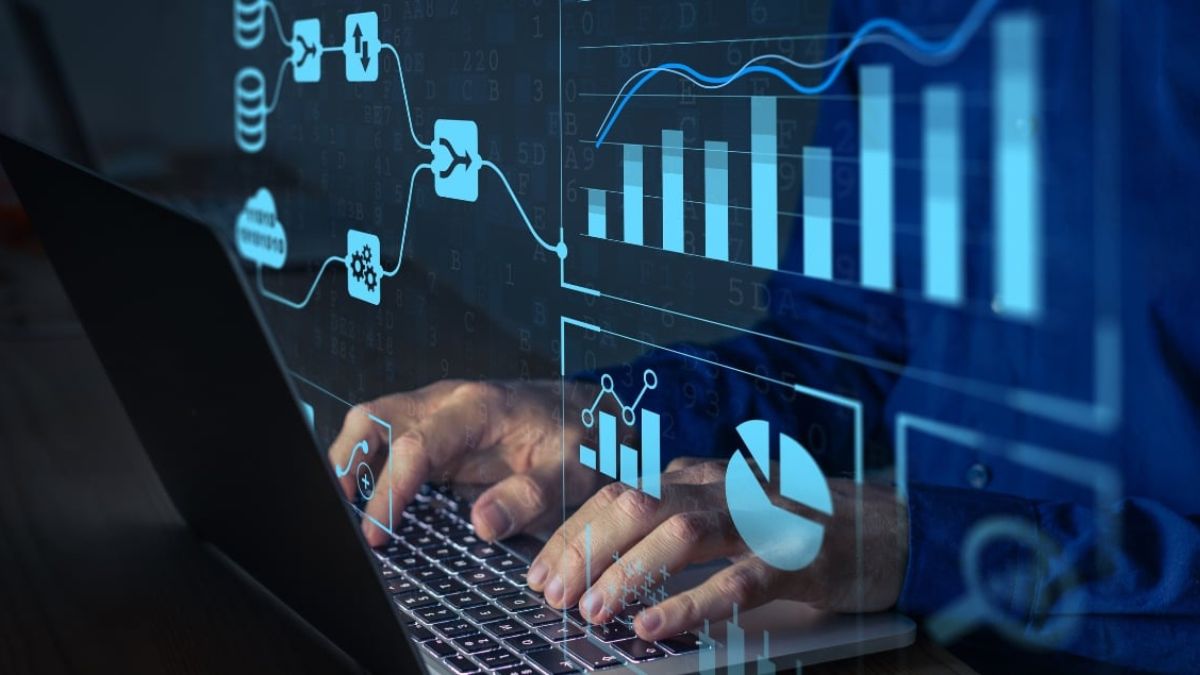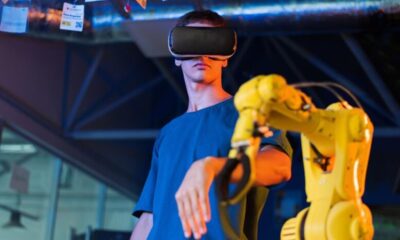TECHNOLOGY
Low Code vs Traditional Development: Which One Wins for Scalability?

Gone were the days when developers would be spending their valuable time writing hundreds of lines of code and transferring logic into convenient solutions by using traditional development methodologies. All such efforts help businesses increase their operational efficiency and reduce costs. Now, the entire software development industry is moving towards adopting new technologies and trends to improve the scalability and effectiveness of software solutions.
You will get hundreds of articles on emerging technologies in software development or software development trends; you will find some common trends in all of these articles. Low code development is one of those most frequently discussed trends in software development. But why? Why is Low-Code trending? Does it work, and is it better than traditional development? We’ll discuss all of these questions in this head-to-head comparison guide on low code vs. traditional development. The benefits and drawbacks of using low-code or traditional development are what we are going to discuss, which will provide you with a clear insight into which software development approach is most suitable for your business.
What is Traditional Software Development?
The traditional development process involves coding manually in languages such as Java, Python, or C#. This is done through manual code, for this business needs to hire software developers with proficient programming skills who can create custom code to develop tailored applications and provide complete control over their capabilities. Additionally, they maintain full visibility and scalability. Specifically, this approach is intended for sophisticated, efficient, business-critical software solutions that demand significant customization and integrations.
Ideal Use Cases:
- Enterprise applications
- High-security systems
- Complex integrations
What’s Low-Code and No-Code Development?
It’s important to understand the distinction between low-code and traditional development before comparing them. I know we are discussing low code vs traditional development, but when we talk about low code, it’s equally important to understand no code also.
No-Code Development
The no-code architecture allows to development of software or code for everyone, even those who don’t have enough technical expertise, because it is completely codeless. The use of graphical user interfaces allows for the creation and deployment of software solutions through drag-and-drop elements. Platforms are typically unencoded and utilized for simpler applications, such as internal processes, mobile apps, and websites. Enterprise-level solutions often lack the flexibility and scalability of no-code platforms, which are not worth considering due to their ease of use.
Ideal Use Cases:
- Simple business applications
- Website and mobile app development
- Internal process automation
Low-Code Development.
In contrast, low-code systems are somewhat more technical and demand some coding skills. These platforms provide developers with pre-made components and templates that can be utilized to accelerate development. While not entirely code-free, low-code development reduces the need for manual coding. It’s fitting for constructing business process automation systems, enterprise applications, and tailored workflows.
Ideal Use Cases:
- Business process automation
- Enterprise applications
- Custom workflows with some technical customization
No-code development is codeless, making it ineffective for creating flexible, scalable software. A No-Code solution is undoubtedly not that effective for businesses looking for scalability. Nevertheless, low code is a more adaptable, flexible, changeable and reliable software development method; therefore, businesses face a dilemma whether they should try low code development or continue with traditional approaches. The misunderstanding is legitimate, which is why the guide on low code versus traditional software development is designed to help you determine which software engineering approach is mot suitable for your next project.
How Does Low Code and Traditional Development Differ From Each Other?
Low code vs traditional development, this comparison requires consideration of various factors, such as coding requirements, speed, scalability, and customization. Listed below are the key characteristics of each approach:
This is the main and basic difference between low-code and traditional software development; now, let’s examine the strengths and weaknesses of both so you can decide which one to choose.
Strength and Weakness Analysis For Low Code vs Traditional Development
Low Code Development
Strengths:
- Enhanced development speed is achieved through the use of pre-built components, drag-and-drop tools, and automation to reduce time spent on development.
- Decreased technical barriers enable non-technical users (such as business analysts or project managers) to contribute to the development of the application.
- A cost-effective approach is used for the short term, as less skilled developers are required and fewer people are needed to handle development work.
- Rapid prototyping facilitates businesses in testing ideas, creating MVPs, and verifying them before they are executed.
- Rapid adaptation to changing business needs is made possible by business agility without the need for extensive redevelopment.
- Low-code platforms often come with pre-installed security features, which can decrease the effectiveness of security setup efforts.
Weaknesses:
- Complicated custom features are difficult to implement due to platform constraints limiting customization.
- This may be hindered by the need to manage large datasets, traffic, or enterprise-level system requirements. That’s why it lacks scalability.
- Deficiencies in security are determined by the platform provider, which means that businesses have little control over encryption protocols or data privacy and compliance.
- The lack of ease in transferring applications built on proprietary low-code platforms to other environments is a significant drawback.
- The performance of pre-built modules may be compromised, resulting in slower performance when used in high-performance scenarios.
- It does not allow for easy integration with legacy systems or third-party APIs outside the platform’s ecosystem.
Traditional Software Development
Strengths:
- Developers have complete control over design, functionality, and performance optimization with full customization.
- Ideal for enterprise-level systems that manage large amounts of data and complex transactions.
- Companies can establish their own security systems, which will ensure compliance with industry standards. Best in providing advanced security & compliance.
- Companies can maintain their codebase and infrastructure independently from third-party providers, without the need for vendor lock-in.
- Integrate easily with any database, API, cloud service or legacy system. Flexible Integration.
- It enables optimized performance, ensuring your applications are optimized for speed, reliability, and large-scale operations.
Weaknesses:
- Personalized programming results in extended development times.
- Requires skilled developers, coupled with rising costs for hiring and operation.
- Organizations require dedicated resources for software updates, debugging, and long-term maintenance.
- A stutter learning curve and input are limited to non-technical users.
- Older applications require longer to adapt compared to low-code solutions.
Depending on your business, which one would be the better option – Understand with Situational Examples
Low code offers speed and cost savings, while traditional development provides flexibility and control, This makes it difficult for businesses to choose between low code and traditional development. When it comes to software development, a balanced approach can provide the best outcome. Let’s understand when to go for low code and traditional development with some situation-based example.
Scenario for Low-Code Development
Consider a mid-level retail business that wants to automate its inventory management system. This company needs a solution that reduces human error and helps it track its stock. Why is this? A low-code platform can be utilized to quickly create and deploy an application, with minimal coding required by the company, in tandem with its current e-commerce system. This approach provides a cost-effective and quick solution that addresses the company’s immediate needs.
Scenario for Traditional Development
If any major bank wanted to create a secure, flexible online banking system that could handle millions of transactions daily, it would need custom-made security, compliance with regulatory requirements, and integration with legacy systems. In this case, traditional development is preferable as it allows full management of the application’s security, performance, and scalability aspects.
Addressing some common questions to avoid the dilemma of choosing between low code and traditional development.
Why are low-code platforms less suitable for scalability compared to traditional development?
Rapid development and prototyping are not feasible on low-code platforms, making them unsuitable for scalability. The complexity of low-code platforms may increase due to high traffic, complex transactions, and intricate integrations. This can be problematic for some applications.
Nevertheless, traditional advancements are more versatile. The architecture and performance of an application can be managed by businesses to create apps that have the capacity to accommodate millions of users, process massive amounts of data (such as emails), and integrate with complex systems.
What is the key difference between security and compliance in low code vs traditional development?
The platform provider typically takes charge of security and compliance in low-code development, which can restrict access to sensitive data and restrictions. Despite the presence of built-in security features, these platforms may not always meet the security standards required by specific industries like finance or healthcare.
In traditional development you can choose the best software development partner who can guarantee your business businesses with complete control over security measures, including encryption, authentication, and regulatory compliance.
Final Thoughts: Which One Wins for Scalability?
Traditional development has the greatest potential for expansion. Despite their ability to deliver low-code development, these platforms are unsuitable for demanding enterprise-level systems and may offer slow performance. Businesses with extensive requirements can rely on traditional development for full customization, scalability, and performance protection.
Businesses can utilize low-code platforms to achieve rapid and cost-effective growth. But for those seeking long-term flexibility, security, and full customization, traditional development is the way to go. A hybrid approach that allows businesses to use low-code platforms for rapid prototyping and automation while still retaining traditional development for core systems and scalability is recommended. This approach helps businesses determine their specific requirements and achieve them successfully.
TECHNOLOGY
Top 7 Reasons Why Remote Data Science & Data Engineering Jobs Are on the Rise

The world of work is changing, and one of the biggest shifts we’ve seen is the rise of remote jobs. From tech companies to large corporations, remote work is becoming the norm. One area that’s growing especially fast is the field of data science and engineering. As more companies embrace the idea of working from home or other locations, data scientist remote jobs and data engineer remote jobs are becoming more common and desirable.
So, what’s driving this change, and why are remote data jobs on the rise? In this article, we’ll go over the top 7 reasons why remote jobs for data scientists and other data-related roles are gaining popularity.
1. The Need for Data Professionals Is Growing Fast
First and foremost, the demand for skilled data professionals is skyrocketing. Almost every business today relies on data to make decisions. Whether it’s improving customer experience, predicting trends, or streamlining operations, data is at the heart of decision-making in almost every industry.
With this increasing demand, companies are looking for ways to fill data roles more efficiently, which is where remote data scientist jobs and data engineer remote jobs come in. Remote work allows companies to access a much wider pool of talent, including professionals from around the world. This is especially important when the competition for skilled data workers is so high.
2. Remote Work Provides Flexibility and Work-Life Balance
One of the biggest advantages of working remotely is the flexibility it offers. Whether you’re a data scientist or a data engineer, working from home or another location means you can better manage your schedule. There’s no need to commute, which saves both time and money. Plus, remote jobs give you the freedom to work from anywhere in the world. You can work from home, a coffee shop, or even while traveling.
This flexibility has made remote data jobs even more attractive. Many people are choosing remote data scientist jobs and data engineering positions simply because they offer a better work-life balance and fewer stressors. Remote work enables you to plan your day around your life, not the other way around.
3. Companies Are Going Global with Their Hiring
In today’s digital world, companies no longer need to be limited by location when hiring. With cloud computing, data storage systems, and online collaboration tools, businesses can hire the best talent from anywhere. Whether you’re based in New York, London, or a small town, remote data jobs allow you to work for companies that would have previously only hired local candidates.
For remote jobs for data scientists and data engineer remote jobs, this shift has opened up an enormous job market. Professionals now have access to a global range of opportunities, and companies can find the right talent, no matter where they’re located. The ability to hire worldwide means businesses can select the best of the best, leading to more innovation and better results.
4. The Tech Industry Is Built for Remote Work
Tech companies, including those hiring for data scientist remote jobs, are naturally well-equipped for remote work. Much of the work done by data scientists and data engineers involves using powerful software and cloud tools that don’t require physical presence in an office. With platforms like Google Cloud, AWS, and various data analysis tools, data professionals can easily complete their tasks remotely.
Since the tools and technologies required for data jobs are accessible online, remote work in data science and engineering is not just possible—it’s often preferred. Many tech companies were among the first to embrace remote work, and they have set the tone for other industries to follow.
5. Cutting Costs for Businesses and Employees
Remote work isn’t just beneficial for employees; it’s also a big win for businesses. Companies that allow their teams to work from home save money on overhead costs like office space, utilities, and supplies. Additionally, they often find that remote workers are just as productive (if not more) than those working in a traditional office setting.
For employees, working remotely eliminates the need for a daily commute, saving time and money. As a data scientist, this means more time spent on tasks that truly matter—analyzing data, creating models, and providing insights—rather than wasting hours in traffic.
6. The Rise of Remote Collaboration Tools
One of the reasons remote data science and data engineering roles have taken off is because of the rise of powerful collaboration tools. Thanks to platforms like Slack, Zoom, Microsoft Teams, and GitHub, remote teams can stay connected and productive no matter where they are located. These tools make it easy to share data, hold virtual meetings, and work on projects in real time.
For remote data scientist jobs and remote data engineer jobs, these tools are essential for collaboration. Data professionals can work closely with colleagues, review data sets, and discuss strategies just as effectively as they would in an office environment. These tools are built for remote work and help maintain strong team cohesion, even across time zones.
7. A Growing Focus on Results, Not Hours Worked
Remote work emphasizes results over hours spent in the office. Many data professionals prefer this, as they can focus on producing high-quality work without the pressure of adhering to a strict 9-to-5 schedule. This shift has made remote jobs for data scientists and data engineers particularly appealing, as it allows for more autonomy and personal control over work.
As long as the work gets done, many companies no longer require employees to clock in at a specific time or work a set number of hours. This results-driven culture is especially beneficial for data scientists and engineers, who often need deep focus and flexibility to solve complex problems. Remote jobs allow these professionals to work during their most productive hours and create better results.
Conclusion: Why Remote Data Jobs Are the Future
There’s no doubt that remote data scientist jobs and data engineer remote jobs are on the rise. The demand for data professionals is growing rapidly, and remote work offers the flexibility, global opportunities, and cost savings that many employees and businesses value. Remote data jobs allow professionals to balance their work and personal lives, collaborate with global teams, and deliver excellent results from anywhere in the world.
If you’re considering a career in data, or if you’re already working in the field, embracing remote work could be one of the best decisions you make. The future of data science and engineering is remote, and now is the perfect time to join this exciting and rapidly evolving field.
TECHNOLOGY
FikFap: Understanding the Latest Trends and Its Impact on Digital Media

The digital media landscape is constantly evolving, and every so often, a new platform or phenomenon emerges as a game-changer. One of the newest players catching the attention of content creators, marketers, and social media users alike is FikFap. From its sudden rise in popularity to its impact on digital media, FikFap has become a hot topic of conversation.
But what exactly is FikFap? Why has it become so popular? And how does it influence the digital media ecosystem? If you’re eager to understand this new trend, you’re in the right place. This blog will break down everything you need to know about FikFap, its significance, its impact on digital media, and what it means for businesses and content creators moving forward.
What is FikFap?
At its core, FikFap is a digital platform that allows users to share and consume short-form video content. Like other platforms in its category, FikFap emphasizes engaging, bite-sized content packaged for a fast consumption cycle. However, what sets FikFap apart is its highly niche focus and unfiltered vibe, catering to an audience looking for more candid, non-traditional content.
FikFap has gained traction largely among Gen Z and younger millennial users, capitalizing on their preference for hyper-authentic, relatable, and often humorous video snippets. The platform encourages creativity and freedom of expression and is rapidly becoming a cultural hub where trends, challenges, and memes are born.
Why Is FikFap Trending?
FikFap’s rise can be attributed to several key factors:
1. Hyper-Specific Targeting
Unlike generic short-form video platforms, FikFap dives deep into a specific niche, providing content that resonates strongly with its target audience. This focus ensures the platform remains highly relevant to those who use it.
2. Authenticity Over Perfection
One of FikFap’s most appealing aspects is its focus on raw, unpolished content. While other platforms lean towards curated and picture-perfect aesthetics, FikFap encourages users to showcase their lives in an unfiltered way. This relatability fosters a sense of community and connection among users.
3. Algorithm-Driven Personalization
FikFap’s algorithm ensures users are served content that aligns with their interests. The platform’s ability to understand user behavior and preferences has resulted in unparalleled engagement and retention rates.
4. Cultural Currency
As a breeding ground for trends, FikFap attracts creators and audiences looking to participate in and shape digital culture. This positions the platform as not just a content-sharing space but also as a trendsetter.
The Impact of FikFap on Digital Media
FikFap is not just a passing trend. It represents a notable shift in how digital media is consumed, created, and monetized. Here’s a closer look at its implications:
1. Redefining Content Creation
With its emphasis on authenticity, FikFap has altered what it means to be a “content creator.” On this platform, you don’t need expensive equipment or professional editing skills to go viral. Creativity, relatability, and timing outweigh production value, leveling the playing field for creators of all experiences.
2. Shifting Audience Expectations
Audiences increasingly expect content to feel “real.” This shift challenges brands and marketers to adjust their strategies, moving away from overly polished campaigns and towards more authentic storytelling.
3. Influencing Marketing Strategies
Marketers can no longer ignore platforms like FikFap if they want to connect with younger, tech-savvy demographics. Brands are experimenting with native advertising, influencer collaborations, and content partnerships designed to blend seamlessly into FikFap’s ecosystem.
4. Creating New Revenue Streams for Creators
FikFap offers monetization features that allow creators to earn income directly through the platform. Whether through ads, sponsorships, or exclusive content offerings, creators now have more opportunities to turn their passion into a career.
5. Fueling the Demand for Micro-Content
FikFap underscores the importance of micro-content in today’s landscape. Bite-sized videos, easily consumable in seconds, are becoming the standard. This is impacting traditional media formats and increasing the pressure on platforms to prioritize short, impactful content.
How Can Businesses and Creators Leverage FikFap?
For businesses and content creators, FikFap presents a unique opportunity to tap into a highly engaged and rapidly growing audience. Here’s how you can make the most of this platform:
1. Understand the Platform’s Audience
Before jumping into FikFap, take time to understand its user base. What types of content are trending? Who is the primary audience? What type of tone resonates with them? Align your content strategy with the platform’s unique culture.
2. Focus on Storytelling
Storytelling remains one of the most powerful ways to connect with audiences. Use FikFap to share behind-the-scenes looks, origin stories, or relatable moments that build a connection between your brand and its followers.
3. Collaborate with Influencers
Influencers are a major driving force on platforms like FikFap. Partnering with the right creators can amplify your reach and lend authenticity to your content.
4. Experiment with Trends
Stay on the pulse of what’s trending on FikFap, and don’t be afraid to join in! Participating in challenges, memes, and popular themes can significantly boost visibility and engagement.
5. Leverage Paid Advertising
Like most modern platforms, FikFap offers paid advertising options that allow businesses to target specific demographics. Use these tools strategically to extend your reach and engage potential customers.
6. Analyze and Adapt
Regularly review analytics to understand what’s working and what isn’t. FikFap’s flexibility allows you to quickly adjust your content strategy based on real-time audience feedback.
What’s Next for FikFap and Digital Media?
While it’s impossible to predict the future with certainty, FikFap’s trajectory suggests that authenticity, relatability, and niche targeting will continue to shape the digital media landscape. Businesses willing to evolve alongside platforms like FikFap will not only stay relevant but also unlock new opportunities for growth.
For content creators, FikFap represents an exciting new canvas to express creativity, build a following, and even generate income. The platform is proof that you don’t need a massive budget or a perfectly curated feed to make an impact.
Final Thoughts
FikFap may be a newcomer to the digital scene, but its influence is undeniable. By challenging traditional norms and prioritizing authenticity, the platform is setting the stage for the next evolution of digital media. Whether you’re a creator, a marketer, or simply a curious observer, FikFap is a platform worth keeping an eye on.
Looking to tap into the potential of platforms like FikFap’s? Start by understanding their dynamics, experimenting with content, and adapting based on feedback. Who knows? Your next big opportunity might just be one short video away.
TECHNOLOGY
The Enigma of U231748506: Unveiling the Nexus of Technology, Culture, and Science

U231748506 isn’t just a string of random letters and numbers; it’s the key to uncovering a fascinating intersection of technology, culture, and science. From revolutionizing technological advancements to reshaping societal norms, this enigma has sparked questions and debates across industries.
What is U231748506? Why does it matter? And how does it connect to some of the most foundational elements of our modern world? This blog aims to dissect the mystery, analyze its impact, and provide a comprehensive look at the intriguing relationship between technology, culture, and science that U231748506 represents.
What Is U231748506?
At its core, U231748506 is a concept born from the fusion of scientific discovery and technological innovation. While not tied to a single definition or physical entity, it serves as a symbol for ongoing exploration in fields such as artificial intelligence, bioengineering, and even cultural studies.
Some suggest it’s a metaphor for humanity’s drive toward integrating technology with life itself. Others see it as a complex idea potentially rooted in real research and systems experiments. Either way, it represents a bold future and the ripple effects of innovation on society.
The Role of Technology
Transformative Innovations Linked to U231748506
Technology is often the scaffolding that supports major scientific theories and cultural changes. U231748506 represents a new paradigm in innovation where AI, machine learning, and complex algorithms form an interconnected web of advancements.
For instance, AI systems utilizing neural networks powered by elements of U231748506-like frameworks are pioneering how machines understand human behavior. From healthcare diagnosis systems predicting illnesses with uncanny accuracy to autonomous vehicles that redefine transportation, these technologies are all rooted in systems designed to adapt and learn.
The Ethical Dilemmas in Technological Progress
But with such progress comes ethical considerations. Can we trust hyper-intelligent AI to make unbiased decisions? Do we risk losing control over innovations whose intricacies surpass human comprehension? These are pressing concerns that not only affect engineers and scientists but also policymakers and everyday consumers.
If U231748506 represents anything, it’s the delicate balance of responsibility and ambition.
How Science and Culture Intertwine with U231748506
Scientific Foundations and Major Breakthroughs
Science moves hand-in-hand with U231748506’s conceptual underpinnings, particularly in biotechnology. Scientists are now creating computational biology models that provide insights into genetics or chemical behaviors too complex for traditional analysis. Imagine simulating evolutionary patterns or the function of enzymes at an unprecedented level of detail.
We’re at the cusp of realizing U231748506-inspired frameworks that would allow predictive and preventative scientific intervention in biology or chemistry. Perhaps in the near future, diseases like Alzheimer’s or Parkinson’s could be thwarted years before they manifest.
The Cultural Shift
Culturally, U231748506 symbolizes more than abstract ideas; it represents society’s willingness to integrate tech into everyday life. From the wide acceptance of wearable technology like fitness trackers that monitor health in real-time to tech-driven art forms including AI-generated paintings, the influence of this concept is undeniable.
It also serves as a measure of cultural attitudes toward technology. Younger generations, for example, are significantly more open to tech-driven experiences like the metaverse or immersive augmented reality. Conversely, skepticism persists among older demographics who question technology’s overreach into personal lives.
Augmented Reality and Artistic Expression
Cultural applications don’t stop at consumer tech. We’ve seen innovations once linked to U231748506-employed systems propel creative industries into entirely new territories. AR-inspired live theater and interactive museums are reshaping the entertainment landscape. Artistic creativity meets mechanical precision, forming a symbolic gesture of mutual respect between technology and humanity.
Tensions in the Nexus
While U231748506’s multifaceted impact is unmistakably positive in many ways, it’s important to note the tensions brewing within this nexus.
Privacy in a Hyperconnected World
If AI systems rooted in U231748506 continue their march into sectors like healthcare and public infrastructure, we will need to elevate conversations around cybersecurity and individual rights. For example, how do we trust systems built entirely around data when data breaches can so easily disrupt lives?
Dependency Concerns
Another source of tension is dependency. Have we allowed technology to consume our daily tasks to such an extent that we’re incapable of functioning without it? Smart home devices that control everything from the thermostat to the locks on the front door may begin to feel less like conveniences and more like vulnerabilities.
These tensions don’t just threaten individual freedoms; they also restrict the natural progression of science when fear overrides curiosity.
The Promise of the Future
Regardless of challenges, U231748506 ignites hope for a brighter, bolder future. It encourages innovation, challenges stagnation, and exemplifies the spirit of discovery.
The next few decades could see advancements we can now only imagine—from eradicating diseases to building fully sustainable smart cities driven by AI-aligned principles. It’s clear that while the questions surrounding U231748506 are many, the opportunities are infinite.
Charting Your Role in the Nexus of Technology, Culture, and Science
As the enigma of U231748506 continues to unfold, the most important takeaway is that every individual, organization, or society involved with tech innovation has a role to play. Whether you’re an entrepreneur leveraging AI to build smarter solutions, or an artist using tech tools to express bold new ideas, the intersection where U231748506 exists thrives on collaboration and shared vision.
Curious to explore how you can harness the power of technology in your field? Stay updated on industry breakthroughs, share your thoughts, and connect with like-minded individuals driving meaningful change forward. Together, we’re shaping this nexus into something extraordinary.
-

 BLOG3 months ago
BLOG3 months agoLiteroticatags: Exploring the World of Erotica and Its Online Community
-

 BLOG3 months ago
BLOG3 months agoErothtos: Understanding Its Role in Today’s World 2025
-

 TECH3 months ago
TECH3 months agoMansrufer: Pioneering Progress in Technology
-

 BLOG3 months ago
BLOG3 months agoWatchmenontheall Calvin: An Exploration of Themes, Characters, and Significance
-

 BLOG2 months ago
BLOG2 months agoUse 1.5f8-p1uzt – A Comprehensive Guide!
-

 TECH3 months ago
TECH3 months agoEggFinder TX Rev C5: A Comprehensive Review and Guide
-

 HEALTH3 months ago
HEALTH3 months agoTransform Fat to Fit: Kettlebell Exercises for Weight Loss
-

 BLOG3 months ago
BLOG3 months agoSüpperlig: A Beacon of Innovation and Competition
